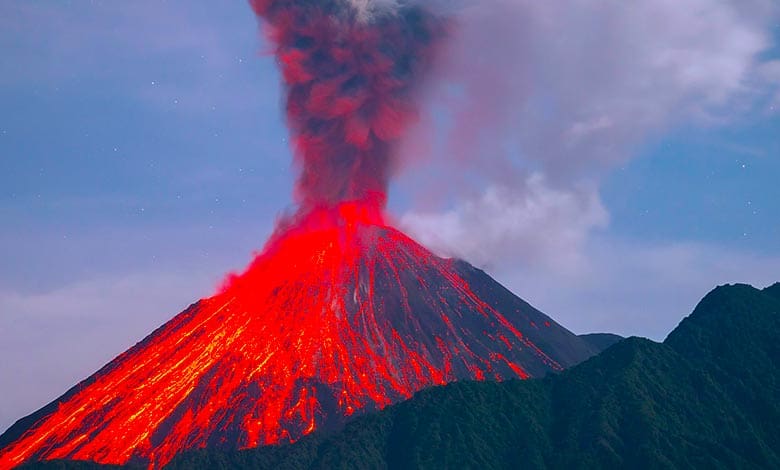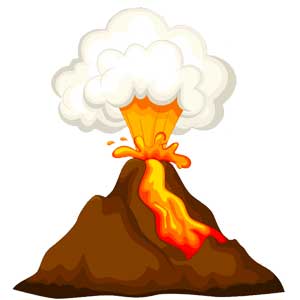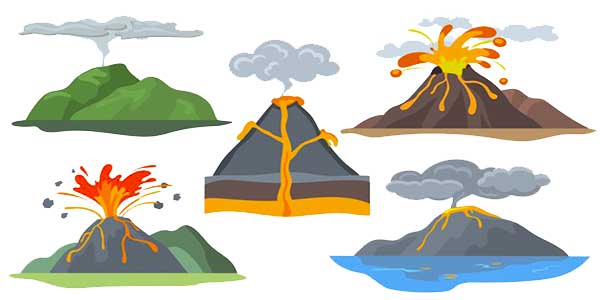
A volcano is a hill or a mountain on the earth’s crest connected to the underground magma chamber. The best part about a volcano is the lava and magma. Lava and magma are two different things. The magma is underground, and lava is when it’s on the surface. So only after the magma breaks the earth’s surface is it called lava.
The lava-spewing explosive landforms can cause devastating damage and produce many islands, including the Hawaiian island. So, how exactly do volcanoes work? It was that volcanoes were mountains filled with fire. Modern science has proven they’re opening to the earth’s red-hot interior. According to the US Geological Survey, there are about 1,500 active volcanoes on the planet. Today, many of them are located along the Pacific Rim and are known as the Ring of Fire.
Venture into the heart of Earth’s most explosive natural phenomena as we explore the mechanisms behind volcanic eruptions. These fiery outbursts are not just spectacles of nature’s fury but intricate processes driven by the movement and melting of the earth’s mantle, revealing the dynamic forces that shape our planet. From magma formation to the dramatic release of pressure, each eruption tells a story of geological transformation.
Why Do Volcanoes Erupt?
Inside the earth, there’s a lot of heat and pressure. Everything that’s inside the earth is molten because of this heat. Because of all this heat and pressure, they’re all liquid or semi-liquid. The earth is something like a pressure cooker. When you cook something at home in a pressure cooker, it becomes very unstable as the pressure increases.
It holds the pressure inside and gets pushed out because of the pressure. In the case of a volcano, the earth has a lot of heat and pressure inside. There are sometimes movements on the surface of the earth. The landmass has moved, creating weak points on the surface, similar to the hole in the pressure cooker.
A sudden hole will erupt, and this pressure will push out all the bolts and stuff inside the earth. When the lava comes out, the molten stuff comes out. It solidifies and creates a kind of mountain or a hill. Once the molten lava solidifies, it forms new landforms.
How do volcanoes erupt?
Volcanoes erupt because the pressure is forced out of the earth’s surface. Some volcanoes explode so big that it makes a huge hole. Some volcanoes have even produced islands like Hawaii.

Volcanic eruptions occur when magma, gas, and other volcanic materials are released. The eruption process involves several factors and processes. Here’s a general overview of how volcanoes erupt:
Magma Generation: Volcanic eruptions begin with the generation of magma deep within the Earth’s mantle. Magma forms when rocks melt due to increased temperature, decreased pressure, and volatile substances like water and carbon dioxide.
Magma Ascent: As magma forms and accumulates in a magma chamber beneath the surface, it seeks a pathway to escape. The magma’s buoyancy, resulting from its lower density than surrounding rocks, causes it to rise towards the surface. The movement of tectonic plates or magma conduits, such as fissures or fractures, can facilitate the ascent.
Volcanic Activity Signs: There are often observable signs of volcanic activity before an eruption. These include increased seismic activity (earthquakes), ground deformation (swelling or subsidence), gas emissions, and changes in thermal activity. Monitoring these signs helps in predicting and preparing for volcanic eruptions.
Conduit and Vent Formation: As magma rises, it may create or enlarge a conduit—a vertical or near-vertical pipe-like structure within the volcano. The conduit acts as a pathway for magma to reach the surface. At the surface, the vent is the opening through which the eruption occurs.
Gas Expansion and Explosive Eruptions: As magma reaches shallower depths, the decrease in pressure allows dissolved gases, mainly water vapor and carbon dioxide, to expand rapidly. This expansion can lead to explosive eruptions. The rapid release of gas-fragmented magma and volcanic ash results in explosive eruptions characterized by ash plumes, pyroclastic flows, and volcanic projectiles.
Effusive Eruptions: In some cases, magma may have a lower gas content or lower viscosity, leading to less explosive eruptions. This type of eruption is known as an effusive eruption. The magma flows more smoothly to the surface, resulting in lava flows rather than explosive bursts.
Eruption Phases: Volcanic eruptions can occur in different phases. Initial explosive phases, driven by the rapid gas release and fragmentation of magma, may be followed by a transition to more effusive eruptions characterized by the flow of lava. Eruptions can also alternate between explosive and effusive phases.
Secondary Hazards: Volcanic eruptions can generate various secondary hazards. These include pyroclastic flows (fast-moving currents of gas, ash, and volcanic fragments), lahars (mudflows caused by volcanic materials mixing with water), volcanic gases (which can pose health risks), and volcanic ash fallout (which can disrupt air travel and impact regional environments).
Volcanoes typically appear along destructive and constructive plate boundaries. When oceanic and continental plates move, a destructive plate boundary forces the marine plate under the lighter continental plate. This friction can cause earthquakes, allowing magma to rise and erupt through cracks. Meanwhile, constructive plates move apart. Volcanoes form here as magma rises to fill the gap. Once magma reaches the earth’s surface, it becomes lava. And once that lava cools, it leaves behind the new rock.
As more eruptions happen over time, a pile of this cooled lava rock builds up in a cone shape, forming volcanoes. Some volcanic eruptions are violent and explosive, while others are smooth and slow-moving. Well, that depends on the magma. If magma is thin and liquid gases can escape, it allows for a smoother flow. How do volcanoes form in the first place? It all has to do with the earth’s layers. The crust comprises many shifting pieces called tectonic plates in the earth’s outermost layer. Together with the upper mantle, these pushes are called the lithosphere.
Tectonic plates shift because of the mantle temperature, and the hotter it is closer to the center than the earth’s top. These volcanic eruptions are less dangerous than the explosive kind because they give people enough time to get out of the way. If magma is sick and sticky gases are stuck. It creates a huge pressure build-up until the gas escapes, resulting in a violent release.
These magma types will explode into the air and break apart into rock fragments called tephra, which vary in size from tiny pieces to the size of a house. These tephra clouds can move fast, destroying virtually everything in their path. If this ash mixes with rain or snow, it can create mudflows that vary entire communities.
Types Of Volcanic Eruptions
By characteristic, there are 2 types of volcanic eruptions:
i) Explosive eruptions: Quiescent is a quiet, calm eruption. Quiescent means calm. It can be detected since the volcano’s summit rises months or even years before erupting. This eruption is where the magma emerges peacefully without flying into the air. Example: Phreatomagmatic eruption.
ii) Quiescent eruptions: Explosive eruptions have high gas content and high viscosity magma, ejecting materials upward. Due to its high viscosity and high gas content. Its viscous gas bubbles accumulate; when they come apart, the pressure decreases, and the bubbles burst.

This is the reason that magma is explosive or the eruption is explosive. Because the gases in the magma accumulate, and when the pressure decreases, they explode and push the magma out, creating an explosive eruption.
There are 5 types of volcanic eruptions. These are:
1. Phreatic or hydrothermal: A steam-driven eruption happens when the hot rocks come in contact with water, producing steam. It is a short-lived eruption characterized by ash columns but may also be an onset for a larger eruption. Example: Mayon volcano in 2020.
2. Phreatomagmatic: It is a violent eruption due to the contact between water and magma. As a result, a large column of excellent ash high speed and sideway emission of pyroclastic called base surges are observed. Example: Taal volcano also demonstrated phreatomagmatic eruption in January 2020. Pinatubo’s eruption in 1991 also demonstrated phreatomagmatic eruption.
3. Strombolian: Strombolian eruption is a periodic weak to violent eruption characterized by a display of a lava fountain. Example: The eruption of Lrazu in Costa Rica is an example of a strombolian.
4. Vulcanian: The volcanic eruption is characterized by tall eruption columns that can reach up to 20 kilometers into the sky with pyroclastic flow and ash flow. Example: Paricutin in Mexico.
5. Plinian: An excessively explosive eruption of gas and pyroclastics. Example: The eruption of Mount Pinatubo in July 1991 is an example of a Plinian type of volcanic eruption.
Factors affecting volcanic eruptions
Some factors affect volcanic eruptions. They are viscosity, temperature, dissolved gases, silica content & volatiles.
- Viscosity – High viscosity mama contains the most significant amount of silica and cool magma. It creates highly violent volcanic eruptions. Low viscosity magma contains a low amount of silica and high temperature. It creates low volcanic eruptions.
- Dissolved Gases – Water vapor and carbon dioxide are dissolved in the magma. Low-viscosity magma allows gases to escape. High-viscosity magma doesn’t allow it to escape gases.
- Silica Content – Low amount of silica creates low volcanic eruptions.
- Volatiles.
Effects Of Volcanic Eruption
How exactly do volcanic eruptions affect human lives as well as the environment?

Hazards from volcanic eruptions are as follows:
- Eruption clouds.
- Lahar flow.
- Lava flow.
- Lava bombs.
- Poisonous gases.
- Pyroclastic flows.
- Volcanic ashes.
Eruption clouds are massive quantities of volcanic ash ejected into the atmosphere. Eruption clouds disrupt the vision of aviators and clog the engines of airplanes. It also causes a localized thunderstorm and brings down acid rain when it mixes with rain clouds.
Lahars are volcanic mudflows. They are very dangerous because they are heavy and can travel downhill fast. It occurs when the volcanic ash and rocks are swept by rivers or heavy rain. Lava bombs are large chunks of pyroclastic materials ejected from a volcano. Poisonous gases such as carbon dioxide and sulfur dioxide can travel down a volcano and suffocate wildlife and humans.
Pyroclastic flows are some of the most dangerous hazards caused by composite volcanoes. Pyroclastic flows are superheated clouds of pyroclastic materials such as hot rocks and tephra, ranging in size from small rocks to houses.
Volcanic ash is composed of fine particles of pyroclastic material that can be carried thousands of miles away by the wind. It can cause ash to fall in areas far away from the eruption site. Also, a huge volume of volcanic ash in the atmosphere can affect the weather and the climate, while it is true that volcanic eruptions can destroy the environment.
What Do You Do If You Caught Near Volcanic Eruptions?
- If you live near an active volcano, you should probably have goggles, masks, and emergency kits.
- Know your evacuation route and evacuate for authorities’ directions to avoid flows and debris.
Volcanoes are just another reminder of the duality of nature. Humans can not control it.
Understanding volcanic eruptions not only satisfies our curiosity about these magnificent natural wonders but also enhances our ability to live harmoniously with our planet, respecting the delicate balance that governs Earth’s geophysical processes. The awe-inspiring power of volcanoes serves as a testament to the ever-changing nature of our world, inviting us to keep exploring, learning, and marveling at the wonders of the Earth.
Read More:
Why Can Not We Use Ocean Water To Put Out Fires?
References:
Heiken, Grant; Wohletz, Kenneth. Volcanic ash. Berkeley: University of California Press.
“Glossary: Effusive Eruption.” USGS.
“Volcanoes of Canada: Volcanic eruptions.” Geological Survey of Canada. Natural Resources Canada.
“How Volcanoes Work: Hawaiian Eruptions.” San Diego State University.
Table of Contents

